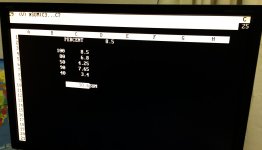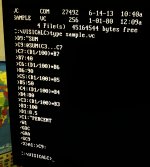voidstar78
Veteran Member
I'm on a physical 5150, I am using XT-IDE with the extended RAM module. I am using DR DOS 3.41 (so 640KB only, no extended RAM stuff).
When I run VC.COM, it does run ok. I can move the cell cursor around.
I can type a label or value. However, when I press ENTER, there is a tone (beep) and the label or value is blanked out.
I noticed at the top right the program is showing "0M" which as I recall means the program thinks there is 0 memory available (hence I assume it is not saving my cell values).
Anyone know what the issue might be? I haven't had memory trouble with anything else (TetraCompositor, Lotus123 2.4, KQ1-4, Oregon Trail, Lemmings, etc.).
re: http://www.bricklin.com/history/vcexecutable.htm
NOTE: vc.com is working for me in 86box with a 486 system w/ MSDOS 6.00 (where I get a "C 27" at top right corner, as I type a few values it goes down to 26, 25, 24, ...).
When I run VC.COM, it does run ok. I can move the cell cursor around.
I can type a label or value. However, when I press ENTER, there is a tone (beep) and the label or value is blanked out.
I noticed at the top right the program is showing "0M" which as I recall means the program thinks there is 0 memory available (hence I assume it is not saving my cell values).
Anyone know what the issue might be? I haven't had memory trouble with anything else (TetraCompositor, Lotus123 2.4, KQ1-4, Oregon Trail, Lemmings, etc.).
re: http://www.bricklin.com/history/vcexecutable.htm
NOTE: vc.com is working for me in 86box with a 486 system w/ MSDOS 6.00 (where I get a "C 27" at top right corner, as I type a few values it goes down to 26, 25, 24, ...).
Last edited:




